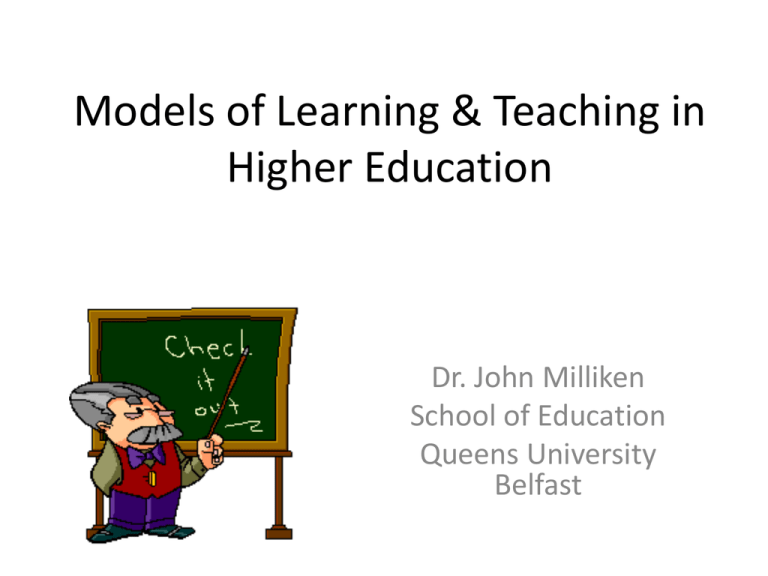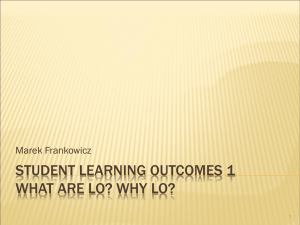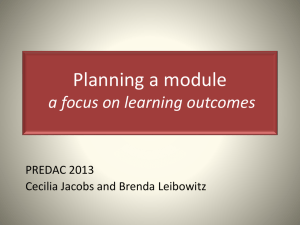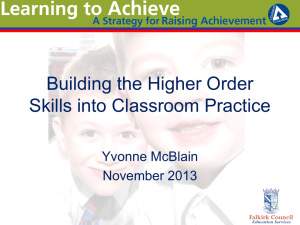Issues in Teaching and Learning in Higher Education
advertisement

Models of Learning & Teaching in Higher Education Dr. John Milliken School of Education Queens University Belfast 3 Types of people/lecturers Prof. Frank Pantridge • Those that make things happen, • Those that watch things happen, • Those that wonder what happened! Learning Learning Outcomes By the end of this session you should:• Be aware of the policies effecting change in higher education • Understand why an accredited teaching qualification in necessary for a career in HE • Appreciate the context within which HE teaching is undertaken • Identify some implications for teaching in the future Learning and Teaching “One learns by teaching; one cannot teach except by constantly learning”. Eble, 1988 5 Teaching I do not wish to be a teacher, I am employed as a lecturer and in my naivete I thought my job was to 'know' my field, contribute to it by research and to lecture on my specialism! Students attend my lectures but the onus to learn is on them. It is not my job to teach them. (Guardian 1991) Curriculum model Specified Enacted Experienced Teaching and Curriculum 1960s Specified Enacted Experienced Teaching and Curriculum 1980s Specified Enacted Experienced Teaching and Curriculum 2000 Specified Enacted Experienced Teaching and Curriculum today Specified Enacted Experienced Hidden (Postmodernism vs Professionalism in Higher Education – J. Milliken) What is learning? “Learning is …. A way of interacting with the world. As we learn, our conceptions of phenomena change, and we see the world differently. The acquisition of information itself does not bring about such a change, but the way we structure that information and think with it does…Education is about conceptual change, not just the acquisition of information” (Biggs, 2002) Words of Wisdom • I hear, I forget • I see, I remember • I do, I understand (Confucius) Conditions for learning • • • • • Clear objectives: expressed as learning outcomes; Students feel a need to achieve those objectives; Motivation: a PRODUCT of good teaching; Students engage with the material; Students can work collaboratively in dialogue with others; • Students receive positive feedback. Learning about learning • • • • • • • Learning about learning has been connected with higher levels of performance Understanding of learning has advanced significantly in last decades Stems from ‘student-centredness’ Also: ‘Learner autonomy and learner independence’ Learning is specific to the social situation in which it was originally learned Thinking about Thinking - ‘metacognition’ Learning about Learning – ‘meta-learning’ which includes goals, feelings, social relations and context of learning Learning styles •Visual learners •Auditory Learners •Kinesthetic /tactile learners (Neill Fleming ‘s Vark) The Kolb Cycle Now What? What? So What? Kolb, David A., (1984) Learning Frameworks for student learning Bloom’s taxonomy of learning Behaviourist theories of learning Cognitive theories of learning Humanistic theories of learning Learning and motivation Bloom’s Taxonomy • • • • • • Taxonomy of Cognitive Objectives 1950s- developed by Benjamin Bloom Means of expressing qualitatively different kinds of thinking Adapted for classroom use as a planning tool Continues to be one of the most universally applied models Provides a way to organise thinking skills into six levels, from the most basic to the higher order levels of thinking • 1990s- Lorin Anderson (former student of Bloom) revisited the taxonomy • As a result, a number of changes were made (Pohl, 2000, Learning to Think, Thinking to Learn, pp. 7-8) Bloom’s Taxonomy • Bloom’s taxonomy is an attempt to classify forms of learning. • It identifies three “domains” of learning each of which is organised as a series of levels or pre-requisites. • Lower levels must be covered before moving on to higher levels – adopts a ‘building blocks’ view of learning. • The three levels are: cognitive affective psycho-motor Bloom’s domains Cognitive Domain Blooms Taxonomy (1956) The judgement and evaluation of characters, actions outcome etc., for personal reflection and understanding The organization of thoughts, ideas, and information from the content The comparison and contrast of the content to personal experiences The converting of abstract content to concrete situations An understanding of what was read The recall of specific information http://www.stedwards.edu/cte/files/BloomPolygon.pdf Original Terms New Terms • Evaluation •Creating • Synthesis •Evaluating • Analysis •Analysing • Application •Applying • Comprehension •Understanding • Knowledge •Remembering (Based on Pohl, 2000, Learning to Think, Thinking to Learn, p. 8) Using the revised taxonomy Why use Bloom’s Taxonomy? • Objectives (learning goals) are important to establish in a pedagogical interchange so that teachers and students alike understand the purpose of that interchange. • Teachers can benefit from using frameworks to organize objectives because • Organizing objectives helps to clarify objectives for themselves and for students. • Having an organized set of objectives helps teachers to: – "plan and deliver appropriate instruction"; – "design valid assessment tasks and strategies“ and – "ensure that instruction and assessment are aligned with the objectives." QUIZ Frameworks for student learning Bloom’s taxonomy of learning Behaviourist theories of learning Cognitive theories of learning Humanistic theories of learning Learning and motivation Behaviourist theories of learning – Learn by being rewarded for ‘right responses (Stimulus-Response model) – Law of ‘positive reinforcement’ – Highly structured materials/externally imposed goals – ‘traditional’ teaching pattern ‘teacher initiatesstudent responds’ Common in work on managing classroom behaviour Difficulties – Behaviour & Learning – – – – – – Making mistakes and taking risks is an important part of learning Learning more process than content based Reducing process to conditioning Invisible things about learning as important as the visible- or observable Learning is active not passive External rewards not always motivating Frameworks for student learning Bloom’s taxonomy of learning Behaviourist theories of learning Cognitive theories of learning Humanistic theories of learning Learning and motivation – – – – – Cognitive theories of learning: social Human beings constructivism are active meaning-makers who construct knowledge rather than ‘receive’ it (Vygotsky) Centres around ’student-centred’ teaching Teacher has to be able to identify the learner’s state of development and ‘learning readiness’ Learners pass through a series of stages of learning development. ZPD: zone of proximal development. Constructivist approaches encourage and promote selfdirected learning as a necessary condition for learner autonomy. The social nature of knowledge. • Learning regarded as interpsychological, taking place with others who may be more experienced. It is defined as a social activity. • As new ideas and knowledge are internalised, learners use language to comment on what they have learnt; language is used to both transmit and clarify new information and then to reflect on and rationalise what has been learnt. • learning moves from the interpsychological to the intrapsychological. Learning and Teaching as Social Activity: implications • • • • • • • Importance of not waiting till a student is deemed ready to absorb things Development of independent processes of learning Learning from cross-curricular perspective Student-teacher relationships change Forms of classroom organisation – collaborative learning Active challenge to notions of intelligence and ability A forum in the classroom where students can have their say. Scaffolding • Support given by a tutor to a learner (Bruner, 1990). Support is given up to the point where a learner can “internalise external knowledge and convert it into a tool for conscious control”. • Learners are led to an understanding of a task by a teacher’s provision of appropriate amounts of challenge to maintain interest and involvement, and support to ensure understanding. Frameworks for student learning Bloom’s taxonomy of learning Behaviourist theories of learning Cognitive theories of learning Humanistic theories of learning Learning and motivation Humanist framework • They emphasise the "natural desire" of everyone to learn. Whether this natural desire is to learn whatever it is you are teaching, however, is not clear. • It follows from this, they maintain, that learners need to be empowered and to have control over the learning process. • So the teacher relinquishes a great deal of authority and becomes a facilitator. Frameworks for student learning Bloom’s taxonomy of learning Behaviourist theories of learning Cognitive theories of learning Humanistic theories of learning Learning and motivation Learning and motivation • Deep and Surface are two approaches to study, derived from original empirical research by Marton and Säljö (1976) and since elaborated by Ramsden (1992), Biggs (1987, 1993) and Entwistle (1981), among others. • Although learners may be classified as “deep” or “surface”, they are not attributes of individuals: one person may use both approaches at different times, although she or he may have a preference for one or the other. Deep & surface learning Based on Ramsden (1988) Learning and motivation (2) • “Deep” correlates closely with intrinsic motivation and “surface” with extrinsic • There is a third form, known as the “Achieving” or strategic approach, in which the motivation is to get good marks. • The Surface learner is likely to be motivated primarily by fear of failure. (Ramsden, 1988) Surface and Deep Learning • Many current university students have been "coached" by their teachers to get the grades they need for admission: they have been trained to be surface learners, and their experience is that it "works". Why should they take the risk of working in a different way? • Surface learning is more likely when learning is isolated from practice. There is a need then to relate academic content to ‘real world’ practices Teaching role in learning • • • • • • • Giving feedback to learners Helping learners become better learners Focusing on motivation Comparing deep and surface learning Experiential learning Looking at the learning process Looking at learning styles Challenges for the future • The need to develop an understanding of holistic learning (intellectual, social and emotional components); • Internationalisation of education; • Greater emphasis on self-directed learning; • Greater understanding of diversity in HE and its impact on approaches to teaching/learning; • Focus on classroom research (action research) to gain a greater understanding of learning strategies; • More research needed on learning styles; • Enhanced understanding of collaborative learning; • HE management must become more aware and accept the needs of enhanced learning and teaching; • Increased use of technology






